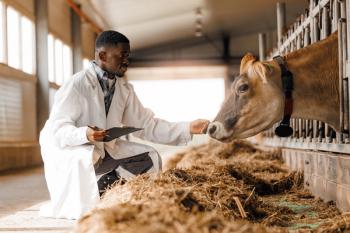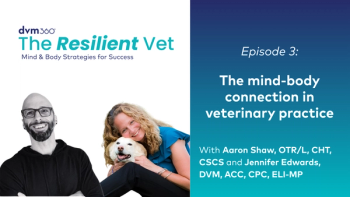
The need for standards of care in animal shelters (Proceedings)
Seven to eight million dogs and cats are admitted to animal shelters each year in the United States. Until recently no comprehensive set of medical care standards for animal shelters had been published.
* Adapted from a presentation developed by Dr. Gary Petronek, VMD,PhD, Vice President for Animal Welfare and New Program Development, Animal Rescue League of Boston
Seven to eight million dogs and cats are admitted to animal shelters each year in the United States. Until recently no comprehensive set of medical care standards for animal shelters had been published. In December 2010 the Association of Shelter Veterinarians published a comprehensive set of standards based upon the "five freedoms;" freedom from hunger and thirst; freedom from discomfort; freedom from pain, injury or disease; freedom to express normal behavior; and freedom from fear and distress.
Goals of the shelter standards document
The primary goal of the standards document is as a tool for improvement and to assist those who are working on behalf of animals to obtain the support they need from their communities for proper care. It is intended to provide shelters and communities a tool for self-assessment and improvement, increase consistency of care of shelter animals across the United States, promote the highest standards of welfare, for existing facilities as well as new construction, provide sound reference material for regulatory purposes when communities look for guidance, provide a benchmark for action when corrective action is needed and create a living document that will be responsive to developments in shelter medicine and animal care.
Scope and intentions
The scope of this project was very broad, and in that context the term "shelter" is used very broadly, to reflect the wide range of organizations and even individuals caring for populations of homeless companion animals. The intent was to develop a document that would be relevant regardless of philosophy or mission or size of an organization; a document that would place the focus on the animals and their needs.
The five freedoms
The concept of the Five Freedoms originated with the Report of the UK Technical Committee to Enquire into the Welfare of Animals kept under Intensive Livestock Husbandry Systems, the Brambell Report, December 1965. The concept was subsequently refined by Farm Animal Welfare Council so that it actually took the form of five freedoms. It has since been further updated and is now the most visited page on the Council's Website. These principles are relevant and appropriate measures of welfare for any animal specie and we tried to be mindful of this throughout the process.
1. Freedom from Hunger and Thirst - by ready access to fresh water and diet to maintain health and vigor.
2. Freedom from Discomfort - by providing an appropriate environment including shelter and a comfortable resting area.
3. Freedom from Pain, Injury or Disease - by prevention or rapid diagnosis and treatment.
4. Freedom to Express Normal Behaviour - by providing sufficient space, proper facilities and company of the animal's own kind.
5. Freedom from Fear and Distress - by ensuring conditions and treatment which avoid mental suffering.
History
The modern animal protection and sheltering movement really began in the mid to late 1800's. Henry Bergh was the son of a wealthy family who witnessed appalling cruelty to horses, which were the backbone of transportation of people and goods, in cities throughout the US and Europe. It was a desire to prevent these abuses that led him to found the ASPCA in 1866. Initially its primary mission was the prevention of cruelty to animals, not sheltering stray and unwanted pets.
Only after Bergh's death in 1894 did the ASPCA assume the responsibility for animal control. The ASPCA kept this role for 100 years. Many other humane societies eventually followed the lead of the ASPCA to absorb responsibilities for animal control, and as a result, animal control and efforts to prevent cruelty often became merged if not muddled. Dealing with an overwhelming number of unwanted pets led to the term "pet overpopulation". Increasingly, the euthanasia of surplus animals became the focus of many organizations, private and muncipal. No one was really prepared for this task, and many inhumane methods of euthanasia were employed. Shelters and the people who worked in them were often stigmatized. The first wave of change in modern sheltering arose in response to both the need to euthanize so many unwanted pets in a more humane manner and to provide respect and credibility to the individuals who struggled with little support to do the best they could with the resources available. Leaders such as Phyllis Wright and the organizations they worked for were instrumental in implementing training, starting professional organizations for shelters and the people who worked in them to greatly raise the standard of care in shelters and sensibilities about the needs of animals. Her mantra of LES is MORE – Legislation, Education, Sterilization – guided shelters for decades, and to a large extent is still quite relevant.
Why develop standards now?
The knowledge base has grown by leaps and bounds in a decade. There are two textbooks directly relevant to shelter medicine, hundreds of research papers in peer-reviewed journals, shelter medicine training programs for students and residents at several veterinary schools. The field of animal behavior has contributed significantly to our knowledge and growing awareness of the complexity of animals minds and their needs and wants. The first decade of the 21st century also saw considerable growth in discussions about mental well-being and quality of life. Unfortunately, as we will discuss, there have been all too many examples where shelters have fallen far short of their duties. And these events have occurred on a backdrop where society is also asking for better and better treatment of animals.
One of the changes in society is the increasing acknowledgment that confinement causes stress, which can result in distress and suffering. Acknowledged for many years for animals in zoo and farm settings but only more recently have we begun to recognize that confinement in shelter settings may be equally deleterious. We know more than we ever did about the needs and wants of our companion animals, and we have an obligation to begin to put that knowledge into practice.
Another reason that standards are timely is the occurrence of all too many situations where those claiming to be protecting animals did them great harm. We cannot undo the harm that has occurred, but we can honor the lives that were lost, learn from these tragedies and do everything we can to ensure that they are not repeated. Events that participated the development of these standards include (but are not limited to):
• The Animal Foundation Lied Animal Shelter
• EDNAH Sanctuary
• Tiger Ranch
• All Creatures Great and Small
• 10th Life Cat Sanctuary
• Thyme & Sage Ranch
• Clean Slate Animal Rescue
• Memphis City Shelter
• Toronto Humane Society
• Heaven Can Wait
• and on and on and on.
Can standards help
The Standards document can establish what is required for a decent quality of life for populations of companion animals. It can begin to dispel the notion that high morbidity and mortality from disease and injury is the norm in shelters. And it can connect expectations of sanitation, medical care, and mental/behavioral well-being to acceptable sheltering, and dispel any notion that these essentials are frivolous "extras" or cosmetic. There is ample precedent for standards. Numerous organizations related to the care of animals have published standards, but until now, none of them related to care of companion animals in animal shelters.
Don't cruelty statues ensure good care?
In many of the examples mentioned, cruelty statues eventually played a role in alleviating the problem. But the conditions must become extreme before cruelty statues in most states become relevant. Cruelty statues fall far short of ensuring adequate, much less optimal, care. When considering the LIED animal shelter, it is important to remember that despite the animal suffering, no cruelty charges were ever filed. The Farm Animal Welfare Council has now built upon the Five Freedoms to conceptualize quality of life on a spectrum, from high to a life not worth living. There may be considerable preventable suffering before a situation may be actionable under cruelty laws.
Overview of content of standards document
1. Operational Issues (Policies, Protocols, Record Keeping)
2. Facility Design and Environment (Primary enclosures, HVAC, Light, Sound)
3. Population Management (Capacity for Care, Monitoring Statistics)
4. Sanitation (Cleaning, Disinfection, Fomite Control)
5. Medical Health and Physical Well-Being (Preventive health care, emergency care, pain, nutrition, response to disease/illness, population well-being)
6. Behavioral Health and Mental Well-Being (Intake, evaluation, in-shelter care, stress reduction, enrichment, behavior modification)
7. Group Housing
8. Animal Handling
9. Euthanasia (Technique, environment and equipment, record keeping, staff training)
10. Spay-Neuter
11. Animal Transport (Responsibilities at origin, during transport, at destination)
12. Public Health (Zoonoses, Animal-related injuries, emerging diseases)
Conclusions
Given the frequency of "abusive" sheltering situations, the need for standards of care has become obvious. The intent of the document is not to be judgmental, but to be helpful. It is understood that very few current shelters live up to all the standards as they are presented. Thus each shelter has something to reach for. It is recognized that many of the standards require financial resources that some organizations do not have. Yet the wellbeing of the animals should be of primary concern to all sheltering organizations. So efforts should be made to follow these guidelines as closely as possible; to live us to these standards as much as resources allow. And to recognize that limited resources limit the numbers of animals that an organization can care for not the level of care provided. Providing poor care to large numbers of animals should never be an acceptable substitute for providing quality care of a smaller number of animals.
Newsletter
From exam room tips to practice management insights, get trusted veterinary news delivered straight to your inbox—subscribe to dvm360.






